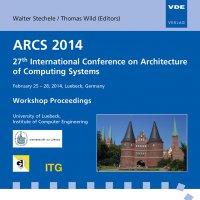The Invasive Network on Chip - A Multi-Objective Many-Core Communication Infrastructure
Konferenz: ARCS 2014 - 27th International Conference on Architecture of Computing Systems
25.02.2014 - 28.02.2014 in Luebeck, Deutschland
Tagungsband: ARCS 2014
Seiten: 8Sprache: EnglischTyp: PDF
Persönliche VDE-Mitglieder erhalten auf diesen Artikel 10% Rabatt
Autoren:
Heisswolf, Jan; Karle, Martin; Singh, Maximilian; Becker, Juergen (Karlsruhe Institute of Technology, Germany)
Zaib, Aurang; Wild, Thomas; Herkersdorf, Andreas (Technical University Munich, Germany)
Weichslgartner, Andreas; Teich, Juergen (University of Erlangen-Nuremberg, Germany)
Inhalt:
Invasive computing is a novel paradigm for massively parallel computing systems. The core objective of invasive computing is to support resource-aware programming through all layers of a system. An invasive application has the ability to explore and dynamically spawn its computation to neighboring processors, taking into account the status of the underlying architecture. The applications can exclusively request the reservation of hardware resources in a phase named invasion. The Invasive Networks on Chip (i-NoC) supports this paradigm by enabling the invasion of communication resources according to the requirements of applications. The monitoring infrastructure of the i-NoC is used by the software layers of the system to determine the location and availability of the resources that are invaded. This work gives an overview on the i-NoC hardware which is required to support invasive computing from the communication perspective. It introduces the i-NoC as a scalable, multi-objective many-core communication infrastructure and presents a concept that takes communication monitoring information into account for the invasion of communication resources. The presented results show how invasion of communication resources can help to improve the performance of a parallel application and reduce its communication energy footprint. Synthesis results investigate the implementation costs of the monitoring infrastructure introduced to take proper invasion decisions.


